Edgar Rice Burroughs’s Mars, Part 5: The Chessmen of Mars
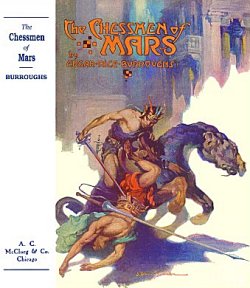 “The squares shall be contested to the death. Just are the laws of Manator! I have spoken.”
“The squares shall be contested to the death. Just are the laws of Manator! I have spoken.”
After Edgar Rice Burroughs pulled the Martian novels in a different direction with Thuvia, Maid of Mars, he retreated from Barsoom for a spell to concentrate on other projects. Eight years passed between the writing of Thuvia and the publication of the next adventure, The Chessmen of Mars, which switched to yet another hero and heroine to hurl into the unknown regions of Mars. In the process, Burroughs gave science fiction a new board game to play.
Our Saga: The adventures of earthman John Carter, his progeny, and sundry other natives and visitors, on the planet Mars, known to its inhabitants as Barsoom. A dry and slowly dying world, Barsoom contains four different human civilizations, one non-human one, a scattering of science among swashbuckling, and a plethora of religions, mystery cities, and strange beasts. The series spans 1912 to 1964 with nine novels, one volume of linked novellas, and two unrelated novellas.
Today’s Installment: The Chessmen of Mars (1922)
Previous Installments: A Princess of Mars (1912), The Gods of Mars (1913), The Warlord of Mars (1913-14), Thuvia, Maid of Mars (1916)
The Backstory
Thuvia, Maid of Mars was a success, and it made sense that when Burroughs returned to Mars he would repeat the same formula of third-person narration and a different hero and heroine pair in a one-off adventure. Although John Carter’s son Carthoris seemed a natural to continue as the hero, Burroughs chose to use a full-blood Martian as his lead for the first time. The decision to change protagonists once before made it easy to do it a second time, and with Carthoris already paired with Thuvia, picking a new character meant ERB could start over with a fresh love interest. (He rarely let his heroes switch heroines once they dedicated themselves. Tarzan could get away with it with La of Opar, but only because of amnesia.)
Burroughs usually wrote each novel in a short space, a month or two. But The Chessmen of Mars took most of 1921 to write, stretching from January to November, worked in with ERB’s other projects, including running his ranch in Tarzana (yes, it’s named after Tarzan), showing movies to friends and family every night, and getting in a car accident on Ventura Boulevard in April. Okay, I don’t know if that last incident affected the writing of the book, but I thought I’d throw it in. I’ve driven on Ventura Boulevard in Tarzana many times. I’d thought I’d throw that in too.
The Chessmen of Mars originally appeared in six installments in Argosy All-Story during February and March of 1922, for which the author received $3,500. The story made a fast transition to hardback, with A. C. McClurg releasing the first edition in November of the same year, featuring a glorious J. Allen St. John cover. Burroughs’s popularity was at such heights now that publishers rushed to get his newest magazine serials into book form.
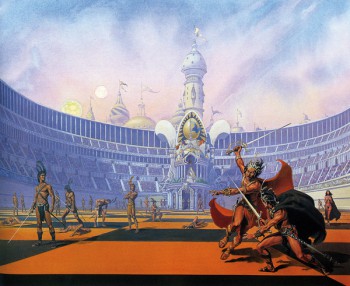 The Story
The Story
The fictional ERB has returned! John Carter, having learned the trick of projecting his image to Earth from the Lotharian bowman Kars Komak, appears to the writer after many years of absence. Inspired by seeing pseudo-ERB’s chessboard, he relates an adventure that happened not to him, but to his daughter Tara.
Tara is engaged to Djor Kantos, but at a celebration she catches the eye of Gahan, the jed from the small city-state Gathol. Gahan impulsively tells Tara he loves her after dancing with her. Tara, confused because of her attraction to the Gatholian, dares to take a solo jaunt that night in her flier. A giant storm seizes her craft, and she ends up lost. With most of Helium’s fleet engaged in a threat against the city, Gahan’s ship is the only one able to go on the hunt for Tara. (Yes, no one from John Carter’s own city is able to search for his only daughter, so the job accidentally falls to a prince from a minor city.)
Tara finds herself in the lush valley of Bantoom, where the ruling inhabitants are the kaldanes, heads on spidery legs that attach themselves to mobile headless bodies called rykors. The kaldanes also eat the rykors, and their king Luud plans to fatten the captive Tara for food.
A storm batters Gahan’s airship, and he falls from it and gets lost in the wilds. After a long journey, he finds himself in Bantoom, where he rescues Tara and escapes with her and Ghek, a kaldane whose people reject him because he shows too much emotion. Tara does not recognize that Gahan is the jed who professed his love to her, and Gahan pretends he is a panthan (a soldier of fortune) named Turan.
The three arrive at Manator, a red Martian nation long isolated from the rest of civilization. The Manatorians capture Ghek, Tara, and Gahan. In prison, Gahan finds A-Kor, a dwar descended from a Gatholian slave-girl and the Jeddak of Manator, O-Tar. The slave-woman was none other than Gahan’s aunt, and he finds out there is an entire slave system of Gatholians.
Gahan escapes from captivity and in disguise enters the jetan game played for possession of Tara. This game of Martian chess is played on a massive board in an arena, with each “piece” fighting to the death for possession of its square against any piece moved against it. Gahan manipulates the match so his side of the game consists all of Gatholian slaves. The battle will not only decide Tara’s fate, but will affect all of Manator and the rebellion brewing outside its gates.
The Positives
Although its plot is standard, The Chessmen of Mars succeeds (for the most part) for the same reason Thuvia, Maid of Mars does: an insanely inventive idea at the crunchy center. Actually, two ideas: the kaldanes/rykors of Bantoom, and the life-sized game of jetan, a.k.a. “Martian Chess.”
The kaldanes are fascinating, and ERB lathers on details about their culture and biology, explaining the ludicrous but still exciting symbiotic evolution of the kaldanes and their “mounts,” the rykors. Burroughs wasn’t satisfied with making this strange dual creature a piece of alien oddity in the story; as he often did, he expanded them into light social parody. The kaldanes/rykor division is a rational/emotional divide that is so polarized it has turned destructive. The kaldanes lack any sentiment, making them stagnant as a civilization, as Gahan explains:
Development of the brain should not be the sum total of human endeavor. The richest and happiest people will be those who attain closest to well-balanced perfection of both mind and body, and even these must always be short of perfection. In absolute and general perfection lies stifling monotony and death. Nature must have contrasts; she must have shadows as well as highlights; sorrow with happiness; both wrong and right; and sin as well as virtue.
Ghek, the kaldane who rebels against his own people when he escapes with Tara and Gahan, has his own observations about his people:
All kaldanes like the same things and dislike the same things. If I discover something new and like it I know that all kaldanes will like it. That is how I know that Luud would like your singing. You see we are all exactly alike.
This is excellent science-fiction material — but it’s only a warm-up for the real juicy part of the novel, the moment all readers anticipate from the moment they hear the book’s title.
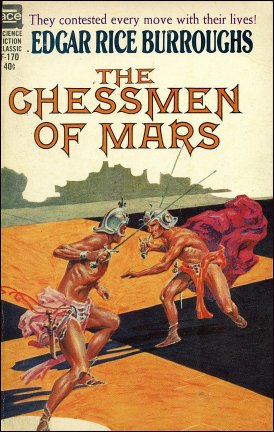 Jetan. Martian Chess. After the green Martians, jetan is the element of Barsoom that readers remember the most. It’s a central part of ERB fandom, and the construction of a jetan board and pieces was once a rite-of-passage for young Burroughs fans. The build toward the great jetan match in Chapter XXVII is fantastic, the battle a tempting carrot dangling before readers through all the sequences in Manator. And when it arrives, Burroughs delivers and outdoes himself.
Jetan. Martian Chess. After the green Martians, jetan is the element of Barsoom that readers remember the most. It’s a central part of ERB fandom, and the construction of a jetan board and pieces was once a rite-of-passage for young Burroughs fans. The build toward the great jetan match in Chapter XXVII is fantastic, the battle a tempting carrot dangling before readers through all the sequences in Manator. And when it arrives, Burroughs delivers and outdoes himself.
Gahan secretly arranges his side of the game to contain Gahalian prisoners loyal to him, and spins it so the game will not only decide the fate of Tara of Helium, but also tip the scales in the civil war brewing outside the walls of Manator. This is superb story-telling, bringing the novel to a peak at the perfect moment. The battle on the jetan arena board is gripping; it is among the best pieces of pure action ERB ever wrote, combining sword-swinging fury with strategy and personal drama. Long after a reader forgets everything else in The Chessmen of Mars — even the kaldanes and rykors — the grand gladiatorial game of chess on the black and orange squares will remain.
Tara is the true hero of the story. Where Thuvia shared time equally with Carthoris in the previous novel, Tara gets the banth’s share of the pages in the first half. It works, since it gives readers a break from the standard swashbuckling masculine heroism. Gahan of Gathol is a supporting character, and Tara is capable of taking the lead as the strongest female protagonist so far in the series. (Phaidor is close, but she’s technically a villainess for most of The Gods of Mars and The Warlord of Mars.) Tara wins enormous points for cold-bloodedly stabbing to death one of her Manator captors. A fine moment for her. And this isn’t the only captor she stabs in the book, although the second one occurs “off-page” and she later finds out her victim was only wounded, not killed. Oh well, good try.
Ghek is also a wonderful character who turns into a co-hero who surpasses the nominal hero. Ghek gives insight into the kaldane psychology and has a character arc much larger and more complex than expected for an ERB novel. But the best part of Ghek is that he’s two parts, a head and body, and can get involved in action and suspense scenes unique to this book. The chapter where he deceives his Manatorian captors in his prison cell by sending his head down into the catacombs of the Martian rats is a genius set piece. Burroughs gets a lot of mileage from Ghek’s physiology.
The time in the creepy catacombs of Manator, where I-Gos the Taxidermist has created a frozen gallery of jetan warriors, is a bit of icing on all the action around the jetan match. I-Gos ends up a surprising character who goes past the generic “weird old man” villain stereotype.
From the basic prose standpoint, The Chessmen of Mars is the best-written novel so far in the series. Burroughs doesn’t sling around as many crazy and gorgeous descriptions, but he also drops far fewer clunkers, and for general readers unfamiliar with the style of the pulps, it is much more readable.
There is one exception to subdued prose style — but it’s dazzling. Chapter IV opens with a portrait of the moons of Mars and the light they cast on the planet. It’s an excellent piece of prose poetry, even if it seems out of place in the pacing:
“Ah, Thuria, mad queen of heaven!” murmured Tara of Helium. “The hills pass in stately procession, their bosoms rising and falling; the trees moves in restless circles; the little grasses describe their little arcs; and all is movement, restless, mysterious movement without sound, while Thuria passes.”
After a two-novel absence, the return of the bookends with the pseudo-ERB is a treat. John Carter now is almost a supernatural, angelic figure in the way he descends to Earth to gift another thrilling story to his favorite scribe. The prologue also introduces the concept of chess, readying the readers for the great battle to come.
An appendix explains the rules for jetan should you wish to get into ERB hobbying and build a board yourself. Or read it here.
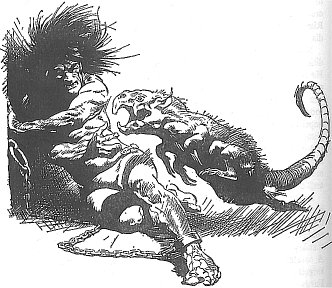 The Negatives
The Negatives
The jetan match and the immediate escape attempt that follows it are such thrilling moments that they should have closed out the book: Gahan, Tara, and the Gatholians reach the attacking armies of U-Thor outside the city and bring down O-Tar in a glorious battle. Unfortunately, the novel chooses instead to slog on for a few more chapters and bring the story to a near halt. From one of the great action highs in early science fiction, The Chessmen of Mars plunges into the most boring part of any of the Barsoom novels so far. Gahan wanders around the city and its catacombs looking for a way to escape, various Manatorians with confusingly similar names bicker over politics, Ghek pops up for too brief a spell, and the story ends in an anti-climax where most of “battle” gets told, Greek tragedy style, via messenger. It’s a thuddingly poor way for an otherwise exciting book to end.
Although the novel has much that’s wonderful going on before the poor conclusion, all its imagination cannot disguise another serious flaw: it’s the same damn thing as the last book. To get all semiotic nutty on you, The Chessman of Mars alters the syntagmatic axis while keeping the paradigmatic axis exactly the same. In other words, the pieces are different, the plot arrangement is identical: a girl engaged sorta falls for another guy, but misunderstandings ensue, she gets lost, guy goes after her through episodic escapades (including finding a city that believes it is the only nation on the planet) before at last making a final rescue and clearing up their love after her previous suitor kindly gets out of the way.
The Chessmen of Mars has an opposite problem from the one that limited Thuvia, Maid of Mars: it runs far too long. Thuvia felt small in scope and sometimes rushed, but here it feels as if there isn’t plot enough to cover the 83,000 words (the second longest book in the series after The Gods of Mars), especially with an ending that doesn’t justify the great length preceding it. The middle section in Manator that leads to the jetan game is sometimes over-convoluted with the internal struggles of people with similar sounding names, when readers just want to get to the big living-chess battle. The kaldanes are wonderful inventions, but the Manatorians could have sustained a shorter, tighter book on their own, much the way that Lothar does in Thuvia. Maybe the kaldanes could have supported a novella. At least they gave us Ghek, but he checks out for most of the last quarter, right when he’s most needed.
Gahan of Gathol is the least interesting hero so far on Mars. There is potential in at last having a full-blooded Martian as the lead, someone without super-strength and stamina. But Gahan comes across as dull, with Tara and Ghek stealing the book away from him. Every time the focus shifts to his part of the story, I wanted to immediately get back to our two other “leads.”
Although Gahan proclaims his love to Tara in the first chapter, she cannot recognize him when he saves her later in Bantoom. This is lazy drama, manufacturing a delayed conflict through the flimsiest of explanations. Burroughs often used artificial reasons to keep his heroes and heroines apart until the end, but this stretches credulity too far, even in a story where massive storms batter both Tara and Gahan to the same lost civilization so they can meet up again. Not knowing who Gahan is makes Tara seem naive, and she is far better than that.
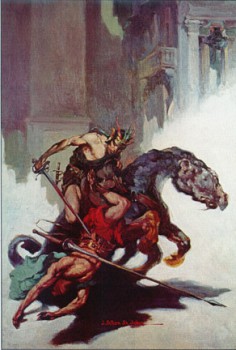 Why does Gahan switch to thinking of himself as “Turan” after he takes on that fake name to disguise his identity from Tara? The name changes over in the writing, which feels strange. Gahan wouldn’t immediately begin to associate himself with a name he just made up, and it can only confuse readers.
Why does Gahan switch to thinking of himself as “Turan” after he takes on that fake name to disguise his identity from Tara? The name changes over in the writing, which feels strange. Gahan wouldn’t immediately begin to associate himself with a name he just made up, and it can only confuse readers.
Craziest bit of Burroughsian Writing: I-Gos the Taxidermist explains searching for new wives after he’s stuffed and mounted the others: “I take my time with them, looking for a new one while I am working on the old. When I am not sure about a new one I bring her to the chamber where my wives are, and compare her charms with theirs, and there is always a great satisfaction at such times in knowing that they will not object. I love harmony.”
Best Moment of Heroic Arrogance: Appropriately, it’s Tara who gets the outré moment, with her brutal stabbing of a character who looked like he was going to be a major villain. Scratch that.
Times a “Princess” (Female Lead) Gets Kidnapped: 3
Best Creature: The ulsio, “the Martian rat,” which proves you don’t have to be big to be threatening.
Most Imaginative Idea: Jetan, what else?
A nomenclature system ERB should have re-thought: The Manatorian names include U-Dor, U-Thor, U-Kal, U-Van, O-Mai, O-Tar, O-Zar, E-Thas, E-Med, I-Gos, I-Zan, and … you see why the scenes of politics in Manator bog down so fast?
Should ERB Have Continued the Series? Uh, I guess. I’m getting a bit fatigued, so maybe he should take some more time off.
Next: John Carter — The Movie! And then, The Master Mind of Mars.
Ryan Harvey is one of the original bloggers for Black Gate, starting in 2008. He received the Writers of the Future Award for his short story “An Acolyte of Black Spires,” and his stories “The Sorrowless Thief” and “Stand at Dubun-Geb” are available in Black Gate online fiction. A further Ahn-Tarqa adventure, “Farewell to Tyrn”, is currently available as an e-book. Ryan lives in Los Angeles, California. Occasionally, people ask him to talk about Edgar Rice Burroughs or Godzilla in interviews.
This and Fighting Man were probably my two favorites after the initial trilogy.
And I’m really enjoying the articles — I’m sure I’ll be rereading the books sometime shortly after I see the movie.
[…] Black Gate (Ryan Harvey) on Edgar Rice Burroughs’s Mars, Part 5: The Chessmen of Mars. […]
Chessmen of Mars was actually the first Burroughs mars book I read!
[…] Gate this coming Friday: a review of the film John Carter [of Mars]. If I’m doing an overview of all of Edgar Rice Burroughs’s Martian novels to coincide with the release of this movie over a hundred years in the making (and in development […]
[…] you’ve been reading my reviews of the Martian novels, then you already know my bias; I am also an Edgar Rice Burroughs fanatic from a young age. As with […]
[…] Mars (1912), The Gods of Mars (1913), The Warlord of Mars (1913-14), Thuvia, Maid of Mars (1916), The Chessmen of Mars […]
[…] Mars (1912), The Gods of Mars (1913), The Warlord of Mars (1913–14), Thuvia, Maid of Mars (1916), The Chessmen of Mars (1922), The Master Mind of Mars […]
[…] Mars (1912), The Gods of Mars (1913), The Warlord of Mars (1913–14), Thuvia, Maid of Mars (1916), The Chessmen of Mars (1922), The Master Mind of Mars (1927), A Fighting Man of Mars […]
[…] not to live. He tells ERB a story about Llana, his granddaughter, child of Gahan of Gathol (hero of The Chessmen of Mars) and Carter’s second daughter, […]
[…] of Mars (1912), The Gods of Mars (1913), The Warlord of Mars (191314), Thuvia, Maid of Mars (1916), The Chessmen of Mars (1922), The Master Mind of Mars (1927), A Fighting Man of Mars (1930), Swords of Mars […]
[…] Mars (1912), The Gods of Mars (1913), The Warlord of Mars (1913–14), Thuvia, Maid of Mars (1916), The Chessmen of Mars (1922), The Master Mind of Mars (1927), A Fighting Man of Mars (1930), Swords of Mars (1934–35), […]